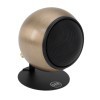- Qualcomm Launches Snapdragon 4 Gen 2 Mobile Platform
- AMD Launches Ryzen PRO 7000 Series Mobile & Desktop Platform
- Intel Launches Sleek Single-Slot Arc Pro A60 Workstation Graphics Card
- NVIDIA Announces Latest Ada Lovelace Additions: GeForce RTX 4060 Ti & RTX 4060
- Maxon Redshift With AMD Radeon GPU Rendering Support Now Available
Managing Your Audio to Keep Neighbors Happy

Whether you live in an apartment or a house ten feet from another, it’s important to make sure that sound levels coming from your home aren’t going to result in trouble from the neighbors. But don’t fret, as there are simple ways for you to tweak your sound to maximize the experience without affecting your neighbors, all of which are explained here.
Page 1 – Introduction
For the past few months, I’ve been working almost exclusively with multimedia PCs. In particular, the ASRock/Intel Atom-based computers that very nicely hook up to HDTV sets and new 1080p monitors. In several cases, these have been connected to high-end audio setups, incorporating some truly impressive gear… 100W channel, 5.1 is pretty typical of current setups.
As the audio power increases, so does the risk of seriously annoying your neighbors. So, I went looking for a solution.
But first, the problem.
Music can be really annoying when it’s not your own, but everyone knows that’s pretty much a volume control solution that’s enacted after unwanted attention from landlords or police. Despite the range of modern audio equipment, modern music usually has a very low dynamic range, so, simply turning it down usually fixes the problem.
Movies, however, pose a somewhat different problem. The “soundscape” of a movie is very complex. There are bands of audio that can cover a dynamic range of at least 60dB, and sometimes more. This began with THX, a theatrical sound system inteded to give movie-goers an “experience” they didn’t get at home. Over time, it’s leaked it’s way into retail DVDs, Blu-rays, and more recently, downloadable movie files.
Generally, a movie has its peak audio devoted to sound effects. We’ll call this 0dB for reference. Dialog tends to be inserted at about -20dB (yeah, that’s a lot quieter), and some of the foley (term for post-production sound effects that enhance the soundscape for a more immersive environment) events such as rustling papers or footsteps begin at about -40dB. In simpler terms, the range between softest and loudest sounds in a single movie can run from barely audible to unbearably loud.
 Credit: Mike Golding |
In an average living-room, the background level (traffic noise, refrigerators, furnaces, air-conditioning, et cetera), is generally around 20 – 30dBA (acoustic decibels as heard by the human ear). To hear the foley effects in a movie, you need to get them above that level, generally around 25 – 35dBA. This means that your average DVD movie can produce peak sound levels beyond 80dBA, which is far too loud to talk over without shouting. And this with the movie turned up just enough to hear the low-level foley effects… never mind that most people crank it up even more.
Further, you should note that decibel scales are logarithmic. If 30dBA requires 0.1W of power, 80dBA would require about 150W… 1500x the power, and that’s going to be very loud.
THX makes this problem even worse because it adds the BIG sound… use of infrasound (frequencies under 100Hz) to give a sense of power and presence in movies. This sound is almost unheard, but when correctly used, it can invoke powerful emotional responses in an audience. It’s about the pitch of the sound, the context in the movie and the levels used.
It takes a lot of power to reproduce sounds this low in pitch. Often, the BIG sound is the highest level audio on a DVD, even though you don’t actually hear it as a discreet sound – and unfortunately, it goes right through walls like they aren’t even there. When removed from context, this BIG sound becomes a booming, thoroughly annoying noise in your neighbor’s home.

If you’re interested in hearing some of what I’m talking about, you can get some THX demo pieces here, and you can read more about infrasound here, or do some quick Google or Bing searching. It’s a truly interesting field of study.
The problem is that in order to hear the quieter parts of the movie, which often includes spoken dialog, you have to turn the volume up tot he point where louder parts are positively deafening, invoking the wrath of your neighbors. This is especially true when you live in an apartment building and have eight other homes only inches from your own.
The solution needed involves three parts. First, you need some way of limiting the maximum volumes so that you’re not blasting your neighbors. Second, you need to boost lower-level sounds so you don’t have to turn up the average volume to hear everything. Third, you need to address the THX BIG sound.
Support our efforts! With ad revenue at an all-time low for written websites, we're relying more than ever on reader support to help us continue putting so much effort into this type of content. You can support us by becoming a Patron, or by using our Amazon shopping affiliate links listed through our articles. Thanks for your support!




